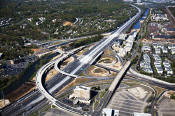 |
The I-95/I-495
Capital Beltway and VA-241 Telegraph Road Interchange, looking west toward
Springfield. Notice new ramp between the Beltway Outer
Loop and Eisenhower Valley (a major business area), this ramp also connects
northbound Telegraph Road to the Eisenhower Valley.
Notice new Beltway bridge over Cameron
Run in upper center of photo. The Beltway
in this area is widened to 10- to 12-lanes on four separate roadways.
Telegraph Road is a 6-lane arterial.
The Woodrow Wilson Bridge is behind this photo, to the east. |
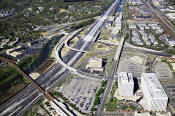 |
The I-95/I-495
Capital Beltway and VA-241 Telegraph Road Interchange, looking west.
A WMATA Metrorail Service and
Inspection Yard is in upper left of the photo; this yard serves the the
Huntington Route (Yellow Line trains), and the Franconia-Springfield Route
(Blue Line trains). This segment of the Beltway
is reconstructed
in the Telegraph Road segment of the Woodrow Wilson Bridge Project, a $236
million contract under construction, and this contract includes raising the
Beltway roadways to provide 5 feet more elevation over Cameron Run to provide
a higher resistance to flooding in heavy rainstorm conditions. Per the VDOT
Dashboard entry for the project on December 2, 2009, the Contract Award was
$236,393,188, the Contract Execution Date was February 12, 2008, and the Original
Specified Completion Date is June 30, 2013. The Contract Execution Date includes
the Notice to Proceed for the contractor. The construction contractor is CK
Constructors, a joint venture of Corman Construction, Inc., and Kiewit Corporation.
The contract to rebuild the I-95/I-495 interchange at Telegraph Road, and
the remainder of the Beltway between the US-1 Interchange project segment
and the Eisenhower Avenue Connector interchange (Virginia Exit 174), will
take 5 years to complete. The contract includes 11 ramps and bridges, 5 box
culvert extensions, drainage improvements, retaining walls, overhead signs,
noise walls, pedestrian paths, landscaping, and environmental mitigation.
These photos show traffic operating on the new outer (local) roadways
of the Beltway, with the new inner (thru) roadways still under
construction.
As of mid-June 2012, the project is nearing
completion, with the new inner roadways of Beltway opening to traffic, and
final paving underway on the new outer roadways of the Beltway.
|
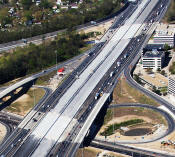 |
This is
a zoom-in excerpt
(size 771 kilobytes)
from the previous photo. Notice to the new mainline Beltway bridges, over
Telegraph Road in the lower left, and over Cameron Run in the upper right.
LARGE PHOTO |
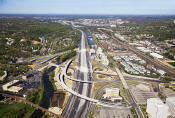 |
The I-95/I-495
Capital Beltway and VA-241 Telegraph Road Interchange, looking west toward
Springfield. |
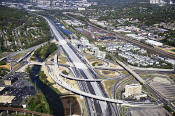 |
The I-95/I-495
Capital Beltway and VA-241 Telegraph Road Interchange, looking west.
Notice Cameron Run passing to the left of the Beltway, then under, then to
the right in the upper part of the photo. |
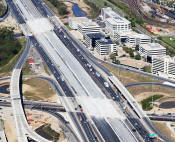 |
This is
a zoom-in excerpt (size 1,043 kilobytes)
from the previous photo. Notice to the new mainline Beltway bridges, over
Telegraph Road in the lower right, and over Cameron Run in the upper left.
LARGE PHOTO |
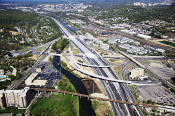 |
The I-95/I-495 Capital Beltway and VA-241 Telegraph Road Interchange,
looking northwest toward Springfield. Notice new ramp between the Beltway Outer Loop and Eisenhower Valley (a major business
area), this ramp also connects northbound Telegraph Road to the
Eisenhower Valley. The new overpasses in the center left, are in the
Southern Interchange Project, designed to provide grade separated
crossings between the first Beltway Outer Loop off-ramp's connection to
southbound Telegraph Road and Huntington Avenue and North Kings Highway,
and these were opened in May 2009, providing a major traffic
improvement over the pre-existing at-grade intersection. The pre-existing
connection had a 4-way at-grade intersection between the ramp, Telegraph
Road, and Huntington Avenue, and it was very congested during peak hours.
Notice the elevated WMATA Metrorail Line in lower part of the photo,
this is the Huntington Route (Yellow Line trains). The line's terminal
Huntington Station is in open cut in the hillside, with large commuter
parking garages below on Huntington Avenue and above on North Kings
Highway. |
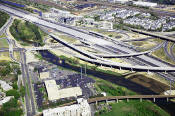 |
The I-95/I-495 Capital Beltway and VA-241
Telegraph Road Interchange, looking northwest. In the foreground are
Cameron Run, and the WMATA Huntington Station for Metrorail. |
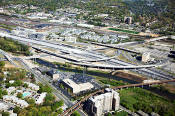 |
The I-95/I-495 Capital Beltway and VA-241
Telegraph Road Interchange, looking northwest. |
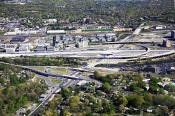 |
The I-95/I-495 Capital Beltway runs left to
right, Cameron Run is just below the Beltway. The VA-241 Telegraph Road Interchange
of the Beltway was originally built in 1961 as a modified cloverleaf interchange
with one semi-directional ramp. The road paralleling just above the Beltway
is the 4-lane Eisenhower Avenue, and it has a long bridge over Telegraph Road.
Telegraph Road runs bottom to top, and its junctions from bottom to top in
order are, North Kings Highway and Huntington Avenue and the first offramp
from the Beltway Outer Loop (towards Wilson Bridge) to Telegraph Road, the
interchange with the Beltway, an interchange with local roads in the Eisenhower
Valley, and the northern terminus of Telegraph Road which has a trumpet interchange
with VA-236 Duke Street in Alexandria. The mainline of the CSXT Railroad and
the Norfolk Southern Railroad parallels between Eisenhower Avenue and VA-236
Duke Street. Telegraph Road mainline bridges in this photo are, over Cameron
Run, over the mainline railroads, and over Duke Street.
The new overpasses in the lower center, are
the Southern Interchange Project, designed to provide grade separated crossings
between the first Beltway Outer Loop off-ramp's connection to southbound Telegraph
Road and Huntington Avenue and North Kings Highway, and these were opened
in May 2009, providing a major traffic improvement over the pre-existing
at-grade intersection. The pre-existing connection had a 4-way at-grade intersection
between the ramp, Telegraph Road, and Huntington Avenue, and it was very congested
during peak hours.
|
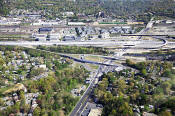 |
The I-95/I-495 Capital Beltway and Telegraph
Road Interchange, looking north along Telegraph Road. |











